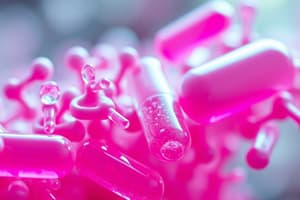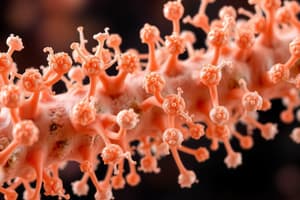Podcast
Questions and Answers
Antibiotics can only be used to treat bacterial infections.
Antibiotics can only be used to treat bacterial infections.
True (A)
The first antibiotic was discovered in 1928 by Sir Alexander Fleming through a planned experiment.
The first antibiotic was discovered in 1928 by Sir Alexander Fleming through a planned experiment.
False (B)
Narrow-spectrum antibiotics affect only a specific group of microbes.
Narrow-spectrum antibiotics affect only a specific group of microbes.
True (A)
A zone of inhibition indicates the presence of bacterial growth around an antibiotic disc.
A zone of inhibition indicates the presence of bacterial growth around an antibiotic disc.
Broad-spectrum antibiotics can lead to an increased risk of developing childhood asthma.
Broad-spectrum antibiotics can lead to an increased risk of developing childhood asthma.
All penicillins contain a b-lactam ring structure.
All penicillins contain a b-lactam ring structure.
Aminoglycosides inhibit protein synthesis at 80S ribosomes.
Aminoglycosides inhibit protein synthesis at 80S ribosomes.
Broad-spectrum antibiotics are less likely to cause superinfection compared to narrow-spectrum antibiotics.
Broad-spectrum antibiotics are less likely to cause superinfection compared to narrow-spectrum antibiotics.
Rifamycin is effective against mRNA synthesis and is used to treat tuberculosis.
Rifamycin is effective against mRNA synthesis and is used to treat tuberculosis.
Quinolones and fluoroquinolones inhibit RNA polymerase for the treatment of urinary tract infections.
Quinolones and fluoroquinolones inhibit RNA polymerase for the treatment of urinary tract infections.
Inherent resistance to antibiotics is due to the transfer of resistance genes.
Inherent resistance to antibiotics is due to the transfer of resistance genes.
Beta-lactamases hydrolyze beta-lactam drugs to confer resistance.
Beta-lactamases hydrolyze beta-lactam drugs to confer resistance.
Efflux pumps in bacteria can help confer resistance to antibiotics.
Efflux pumps in bacteria can help confer resistance to antibiotics.
Allergy testing can determine substances that cause allergic reactions.
Allergy testing can determine substances that cause allergic reactions.
NRTIs are a type of antihelminthic drug.
NRTIs are a type of antihelminthic drug.
Chloroquine and quinacrine stop RNA synthesis by intercalation between base pairs.
Chloroquine and quinacrine stop RNA synthesis by intercalation between base pairs.
Flashcards
Antimicrobial Drug
Antimicrobial Drug
A drug used to treat microbial infections.
Antibiotics
Antibiotics
Drugs that kill or inhibit the growth of bacteria, used to treat bacterial infections.
Zone of Inhibition
Zone of Inhibition
A clear area on a plate where bacteria don't grow, indicating the effectiveness of an antibiotic.
Narrow-Spectrum Antibiotics
Narrow-Spectrum Antibiotics
Signup and view all the flashcards
Broad-Spectrum Antibiotics
Broad-Spectrum Antibiotics
Signup and view all the flashcards
Inhibition of Cell Wall Synthesis
Inhibition of Cell Wall Synthesis
Signup and view all the flashcards
Inhibitors of Protein Synthesis
Inhibitors of Protein Synthesis
Signup and view all the flashcards
Inhibitors of Nucleic Acid Synthesis
Inhibitors of Nucleic Acid Synthesis
Signup and view all the flashcards
Inherent Resistance
Inherent Resistance
Signup and view all the flashcards
Acquired Resistance
Acquired Resistance
Signup and view all the flashcards
Beta-lactamases
Beta-lactamases
Signup and view all the flashcards
Aminoglycoside-modifying enzymes
Aminoglycoside-modifying enzymes
Signup and view all the flashcards
PBP Mutations
PBP Mutations
Signup and view all the flashcards
Efflux Pumps
Efflux Pumps
Signup and view all the flashcards
Antifungal Drug
Antifungal Drug
Signup and view all the flashcards
Antiretroviral Drugs
Antiretroviral Drugs
Signup and view all the flashcards
Study Notes
Antimicrobial Drugs
- Antimicrobial drugs treat microbial infections.
Antibiotics
- Antibiotics kill or inhibit bacterial growth, treating bacterial infections.
- They fight pathogens.
- These drugs interfere with cell wall formation.
- Many are derived from bacteria or fungi; others are synthetically produced.
History of Antibiotics
- The first antibiotic's discovery was accidental.
- In 1928, Alexander Fleming noticed a clear area of no bacterial growth where a fungus contaminated a culture plate.
Zone of Inhibition
- If an antibiotic stops bacteria growth or kills them, a zone of no bacterial growth forms around the antibiotic.
- Factors affecting zone size:
- Drug diffusion rate
- Drug concentration
- Type of microorganism
- Type of drug
Narrow and Broad-Spectrum Antibiotics
- Narrow-spectrum: affect a specific group of microbes, like gram-positive bacteria (e.g., Erythromycin, Clarithromycin, Clindamycin).
- Advantage: less likely to harm normal body microorganisms.
- Use: only when the causative organism is identified.
- Broad-spectrum: affect a wide range of microbes (e.g., Azithromycin, Amoxicillin, Vancomycin, Levofloxacin, Streptomycin, Tetracycline, Chloramphenicol).
- Disadvantage: Increased risk of harming normal body microorganisms, leading to superinfections or drug resistance.
Antibiotic Targets
- Bacterial cell wall
- Bacterial plasma membrane
- Bacterial protein synthesis
- Bacterial nucleic acids (DNA/RNA)
- Bacterial metabolism
Inhibitors of Cell Wall Synthesis
- Penicillins, containing a β-lactam ring, are effective against gram-positive bacteria produced by Penicillium.
Inhibitors of Protein Synthesis
- Aminoglycosides, tetracyclines, chloramphenicol, and macrolides inhibit protein synthesis at 70S ribosomes.
Inhibitors of Nucleic Acid Synthesis
- Rifamycin inhibits mRNA synthesis and is used to treat tuberculosis (Mycobacterium tuberculosis).
- Quinolones and fluoroquinolones inhibit DNA gyrase for urinary tract infections.
Antibiotic Resistance
- Resistance can be inherent (present in some bacteria naturally) or acquired (through gene transfer/spontaneous mutations).
Mechanisms of Antibiotic Resistance
- Enzyme production: Enzymes like beta-lactamases modify antibiotics to deactivate them. Enzymes often result in inactivation.
- Aminoglycoside modifying enzymes.
- Chloramphenicol acetyl transferase.
- Mutations in bacterial structures (e.g., penicillin-binding proteins [PBPs])
- Efflux pumps expelling antibiotics from the bacteria
Allergy Testing
- Used to identify substances causing allergic reactions.
- Skin prick test
- Patch test
Antifungal Drugs
- Treat and prevent fungal infections (mycoses).
- Classes:
- Polyenes
- Imidazoles
- Triazoles
- Allylamines
- Inhibitors
Antiretroviral Drugs
- Treat viral infections, specifically targeting different aspects of viral life processes.
- Classes:
- Nucleos(t)ide Reverse Transcriptase Inhibitors (NRTIs)
- Non-Nucleoside Reverse Transcriptase Inhibitors (NNRTIs)
- Protease Inhibitors
- Entry Inhibitors
- Integrase Inhibitors
Antiprotozoan and Antihelminthic Drugs
- Treat parasitic infections
- Examples: Chloroquine, quinacrine, metronidazole, niclosamide.
- Mechanisms can include stopping DNA synthesis or parasite growth.
Studying That Suits You
Use AI to generate personalized quizzes and flashcards to suit your learning preferences.
Related Documents
Description
This quiz covers the essentials of antimicrobial drugs, focusing specifically on antibiotics. It examines their mechanisms of action, the history of their discovery, and concepts like the zone of inhibition and spectrum of activity. Test your knowledge on how these important compounds combat microbial infections.




